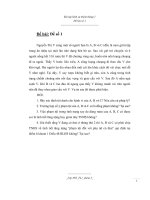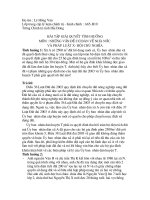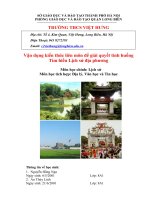Phương pháp giải quyết tình huống pháp luật bằng IRAC pdf
Bạn đang xem bản rút gọn của tài liệu. Xem và tải ngay bản đầy đủ của tài liệu tại đây (107.12 KB, 13 trang )
Phương pháp giải quyết tình huống
pháp luật bằng IRAC
IRAC là gì? Theo Wikipedia thì IRAC (đọc là EYE-rack) là viết tắt của 4 từ sau:
Issue, Relevant law, Application facts, và cuối cùng là Conclusion. Nó được dùng
làm phương pháp để phân tích các tình huống pháp luật.
Ý nghĩa của nó có thể hiểu như sau
1. Issue: các sự kiện có ý nghĩa pháp lý, các tính chất pháp lý của vụ việc. Các vấn
đề cần giải quyết. Các câu hỏi của khách hàng đặt ra. Thường thì câu chuyện rất
dài, rất nhiều tình tiết nhưng ta chỉ cần tóm lượt được tình tiết có ý nghĩa pháp lý.
Chẳng hạn anh A yêu chị B sắp đi đến kết hôn nên anh A quyết định mua một căn
nhà để sau này về sống chung, Anh A có mượn của má chị B là bà M một số tiền
để mua căn nhà đó. Tự nhiên anh A bị tai nạn nằm bệnh rất lâu rồi mất. Bà M đòi
gia đình anh A phải đưa căn nhà đó cho chị C
Tóm gọn lại sự kiện trên ta chỉ cần quan tâm : A và B chưa có kết hôn. A sở hữu
căn nhà x. A mượn bà M một số tiền y. A chết. M đòi sở hữu nhà do A để lại.
2. Relevant law: pháp luật liên quan trong trường hợp này là gì? dân sự, hình sự,
hành chính hay thương mại. Có thể áp dụng tập quán pháp không? Cũng có thể là
các bản án đã xử, để tìm hiểu các vận dụng luật của quan tòa trong tình huống cụ
thể đó như thế nào.
Có nơi thì gọi là Rule: cũng có thể hiểu là các quy tắc pháp luật nào được áp dụng.
3. Application facts: chổ khác thì gọi là Analysic còn nói đơn giản là vận dụng
luật cụ thể vào tình huống của mình như thế nào. Tại sao dùng điều luật này mà
không vận dụng điều luật khác. Đây chính là phần quan trọng nhất vì nó giải thích
các vấn đề đặt ra ở phần 1.
4. Conclusion: Đây là phần kết luận cuối cùng giải đáp các vấn đề đặt ra ở phần 1.
The IRAC Method of Written Legal Analysis: A Writting Tool for Legal
Assistants
While working in a law office as a paralegal or other research position, your
supervising attorney will request that you make a written analysis of each case you
research. He/She will more than likely expect that you know how to do this. The
results of your legal analysis should be put into writing so that they can be used in
the future in addition to the case at hand.
The written analysis will likely mirror your thought process during your research.
This written analysis of a case needs to be concise and to the point. All of the
necessary facts must be present but an attorney or judge basically wants to know
four things:
Issue-what your client's problem is
Rule-what the rule is
Analysis-how that law will affect your client's case
Conclusion-what you expect to be the likely result
One widely accepted method for conveying your thoughts in a logical order is
known as IRAC. IRAC is an acronym for Issue, Rule, Analysis, and Conclusion.
The IRAC approach is certainly not the only approach and nor is it always the
best, but it is always a very good starting point. Here is the basic information to be
contained in each of the IRAC elements:
Issue
Create a topic sentence that states the issue you will be discussing in the
paragraph. Again, make this brief and concise. Only use one issue in this
paragraph. If your case includes different issues, use the IRAC method for each
issue.
Rule
In this section, you need to state the rule of law that you found to govern the
particular issue at hand. Be sure to quote the exact statutory language. However, if
the statute is long, quote only the relevant language. You should use ellipses to
show any omissions but be sure that your omissions do not change the rule or
statute's meaning.
Analysis
Now you need to explain how the statute and policy of the statute will determine
the outcome of your client's case. Be sure to note the strengths as well as the
weaknesses of your argument so that your attorney can be prepared. You will also
be doing your client a great disservice by not pointing out the pros and cons of
your application of the law to his or her case.
Conclusion
You must conclude the analysis. You cannot leave your reader to make their own
conclusion because that is what you were asked to do. Tell your reader what the
outcome of the case is likely to be in relation to the research. As noted earlier, this
IRAC method is to be used for each issue pertaining to the facts of your client's
case. Include a paragraph for each issue. Also include in your written analysis a
"road map" paragraph that outlines the events that led to the case. Tell your reader
what happened to get your client to this point. After using the IRAC method on all
of your issues, include a concluding paragraph. This will include the incorporation
of all of the elements and issues of the case and how the case is likely to turn out
based on your legal analysis.
When working in a law office you must also first consult with your supervising
attorney on what he or she prefers. Some attorneys would rather use a CRAC
method that starts with a conclusion. Many attorneys still find this IRAC method
to be very effective in conveying a legal analysis. Also be sure to use transitions to
help your reader move from one thought to the next and to see the connections
between them. Legal research is often regarded as the most important job a legal
assistant has in a law office, however without an effective way of communicating
that research to your attorney, it is just a thought.
Briefing Cases The IRAC Method
When briefing a case, your goal is to reduce the information from the case into a
one-page case brief. When we discuss the case in class, you will immediately be
able to discern the problem the court faced (the issue); the relevant law the court
used (the rule); how the facts of the case applied to the rule (the application); and
the outcome (the conclusion).
Follow the “IRAC” (Issue; Rule; Application; Conclusion) Method.
Facts:
For case briefs only (not exams), write a brief synopsis of the facts as the court
found them to be.
Procedural History:
For case briefs only, write as much information as possible about the history of the
case. What court authored the opinion? The Supreme court? Court of Appeal?
What was the decision(s) below? Did the lower court issue the decision following
a court trial, jury trial, or motion for summary judgment?
Issue:
Next, identify the issue(s). Usually, only one issue will be discussed, but
sometimes there will be more. What is the fight over in the case?
For example, the main issue in Roe v. Wade was whether a state could
constitutionally restrict a woman from procuring an abortion without violating the
14th Amendment.
Rule(s):
Next, list the relevant rule(s) of law that the court identifies. Each case will give a
discussion of the relevant law.
Application:
This is probably the most important portion of the brief. The case will undoubtedly
discuss how the facts interplay with the relevant rule(s) of law.
Conclusion:
What was the final outcome of the case? This should be a short statement.
What is IRAC?
IRAC stands for Issue, Rule, Application, Conclusion. It is one way to structure
legal analysis. An effective essay (no matter the overall length) follows some form
of the IRAC structure where it is organized around each of these elements for each
and every issue and subissue identified as a legal problem.
IRAC is an extremely useful tool in organizing any law related essay answer. It is
not the only way to structure an answer, but it helps to make sure all bases are
covered.
So, until you achieve the level of mental and written fluency where you can weave
together rule and fact in a seamless tapestry and transition between thoughts
without loss of either the substance or your reader, you might choose to rely on
some form of IRAC to keep focused. Use IRAC as tool for organizing your
thinking and your writing.
Think of it as a weaving loom that is there only to support the threads of your
argument, while you weave and create an intricately beautiful piece of fabric, i.e. a
complete, logical argument. Soon, the process will become automatic and you will
rely less and less on the loom. Until then, you have something you can rely on to
guide you through the process.
How to IRAC
1. State the issue
The issue is the most important element in the analysis and must be stated in a
way[COLOR=rgb(0, 0, 0)][/COLOR]to show what is in controversy. The legal
question weaves together the rule and the facts particular to the problem you
identified.
Articulate the issue by creating the legal question presented by the facts. To find
the issue, ask: “what is in controversy in these facts.” (Of course you need to know
the law to find a legal question in the facts.) Use the “whether, when” structure to
help you isolate and write an issue statement. Some professors might not want to
see this particular language – “the issue is whether.” You achieve the same result
with other words – “Did” or “Can.” Don’t get fixated on language. Follow your
professor’s instruction, either way you achieve the same result: identification of
the legal problem.
You should always use the following language to guide your thought process:
“The issue is whether,” . . . then identify and state the legal conclusion you want
the court to reach . . . Don committed a battery, (or an offer was made, or the court
can assert personal jurisdiction) . . . and connect to the “relevant” facts (the
relevant facts being those facts which impact the outcome) . . . when he pushed
Pam even though he knew she was in no danger of being hit by the bicyclist (or
when he said, “would you buy my watch for $500 in cash next Tuesday?” or when
the defendant conducted business in the forum state, had an office and a full-time
staff, and paid state taxes). When completed, the sentence will read: “The issue is
whether Don committed a battery when he pushed Pam even though he knew she
was in no danger of being hit by the bicyclist.”
2. State the law
After you have the issue, you must articulate the rule. The rule and the facts are
inextricably linked. Your analysis of the facts will not make sense unless you have
first identified the rule which determines the legal meaning to be attributed to
those facts.
Use building blocks for writing the rule of law, consider:
♦ Elements
♦ Definitions
♦ Exceptions to the general rule
♦ Limitations to the rule
♦ Defenses
When writing, follow a hierarchy of concepts by:
♦ Moving from the general to the specific
♦ Defining each legal term of art
Identify:
♦ The consequences of applying the rule – what will happen?
♦ What are the consequences of this rule in this situation?
Which leads you to consider:
♦ What does application of the rule mean here? What will be its effect?
3. Analyze the facts in light of the law
The analysis or application is the heart of the discussion and sometimes works
better combined with the rule. It is where you examine the issues raised by the
facts in light of the rule. Your statement of the rule will drive your organization of
the analysis.
You simply match up each element you have identified in the rule (in order) with a
fact, using the word “because” to make the connection between rule and fact.
“Because” is the single most important word to use when writing the analysis.
Using the word “because” forces you to make the connection between rule and
fact. Also make use of the words “as” and “since” — they serve the same function
as “because” and sometimes will sound less redundant when used in the same
paragraph as “because.”
4. Conclusion
Conclude each issue before drawing your final overall conclusion. There is no
right or wrong answer, only logical analysis based on the rule and the facts which
lead to a reasonable conclusion. Note: Repeat the process for each issue you
identify — each issue forms the basis for a separate IRAC analysis.
Examples
1a. Don’t write:
In this case, while Pete the police officer was giving Dan a sobriety test, he
noticed that Dan fit the description of an eyewitness to the robbery, giving the
police officer probable cause to arrest Dan.
1b. Do write:
In this case, Pete the police officer realized that Dan fit the description of the
suspect, providing probable cause for arrest, because Dan was extremely tall at
6’4”, was wearing a green and tan sweater with purple patches and pointy-toed
alligator cowboy boots, fitting the description provided by the eyewitness to the
robbery.
2a. Don’t write:
ABC Inc. engaged Dr. Jones to develop a drug that reduced hair loss. Dr. Jones
worked in his own laboratory, hired and fired his own assistants and set their
working hours as well as his own. He meets with the President of ABC every
Friday morning to discuss progress on the project, and at this time, Dr. Jones
submits his timesheet for payment. The President pays Dr. Jones weekly.
2b. Do write:
Here, Dr. Jones can be considered an independent consultant for ABC Inc.
because he completes all the research and development work in his own
laboratory, in a separate facility from that of ABC, where he has direct control
over the employees because he hired his own assistants, setting their work hours.
He also exercises direct control over his own work because he sets his own work
hours and only meets with ABC once a week. Further, since he only meets with
the President of ABC on a weekly basis to discuss progress on development of the
hair loss product, the President does not supervise Dr. Jones on a daily basis as to
the work which goes on in the laboratory.









